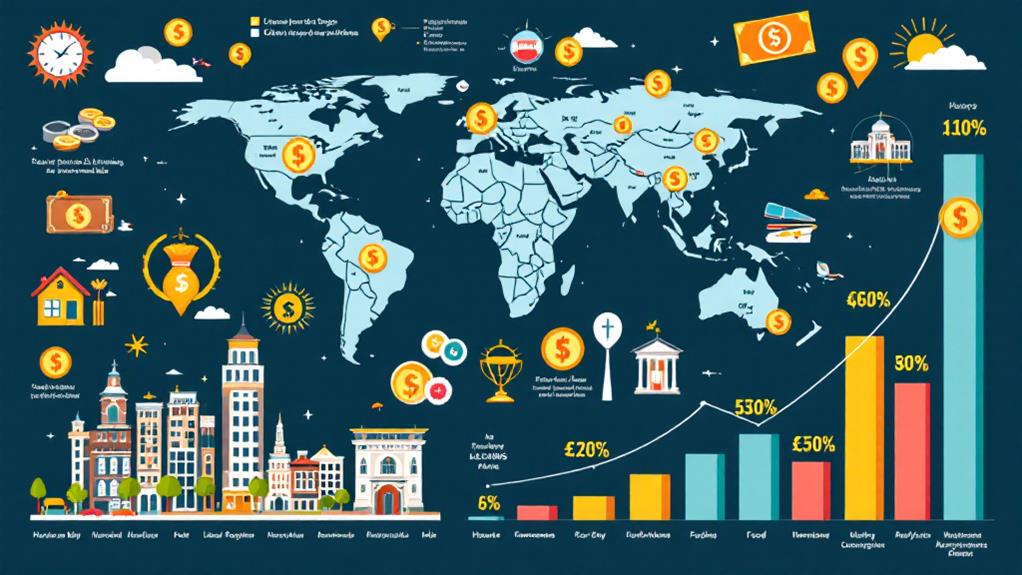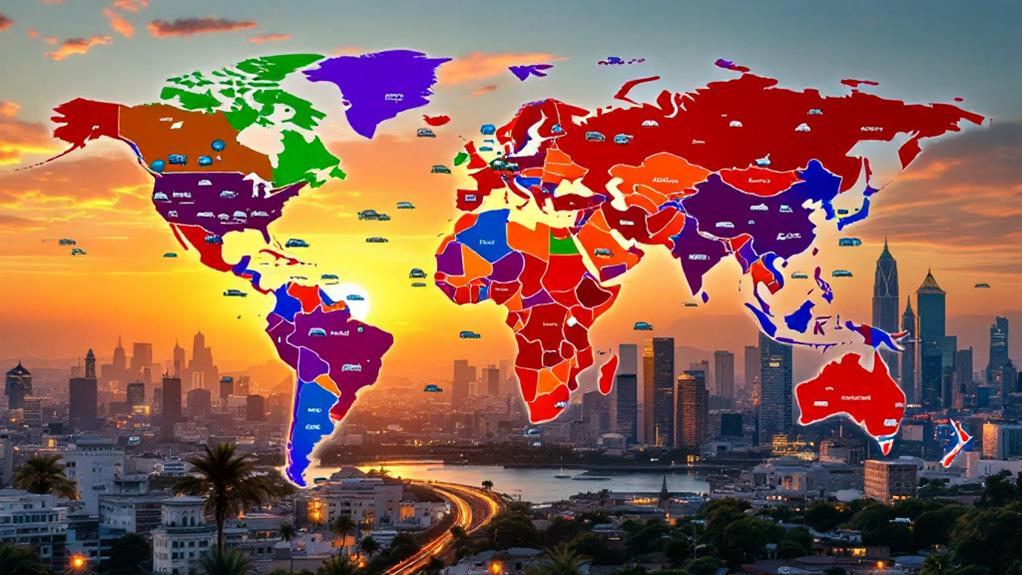The Most Expensive Countries to Live In

You're investigating the domain of high living costs, starting with Switzerland, where a cost of living index of 122.4 places it at the top. Norway and Iceland closely follow with indices of 101.43 and 100.48, respectively. Japan and Denmark add their unique flavors, with sky-high expenses in cities like Tokyo and strategic welfare systems. Factors like housing, local demand, and economic stability shape these costs considerably. Understanding these contributing elements can reveal why Monaco, the Bahamas, and Luxembourg also make the list of pricey places. Delve further to see how living costs impact everyday life.
Cost of Living Overview
Living in some parts of the world can feel like steering through a financial maze, where each turn reveals another layer of expense. You might find yourself maneuvering through countries like Switzerland, which tops the list of expensive countries with a intimidating cost of living index of 122.4. This figure eclipses the global benchmark set by New York City at 100. Such a high cost of living often means you'll face steep living costs, particularly in housing prices, which can consume a significant portion of your budget.
If you're considering a move to Norway or Iceland, prepare for similar financial challenges. These countries also rank high due to economic factors such as inflation and housing demand, which drive up costs. In Monaco, the average monthly cost of living soars to approximately $6,538, making it an exclusive enclave for those who can afford it.
Japan and Denmark, though slightly less expensive, still demand careful financial planning, with indices at 83.35 and 31.92, respectively. Understanding these economic factors and grasping the living costs in these regions can help you make informed decisions about relocating or traveling to these high-cost areas.
Ranking Methodologies
When evaluating the cost of living across different countries, understanding ranking methodologies is essential. These methodologies offer insights into why some countries are deemed more expensive than others. They often rely on data from studies, media reports, and indices like the Consumer Price Index (CPI) to assess living expenses. For instance, CEOWORLD magazine uses New York City as a benchmark, assigning it an index score of 100. This allows for clear comparisons: countries scoring above 100 have higher costs of living, while those below have lower costs.
These rankings don't just stop at living expenses. They also consider factors such as purchasing power, which reflects how much a currency can buy regarding local goods and services. The Grocery and Restaurant Price Index further captures variations in food and dining expenses across expensive countries. High quality of life, while subjective, is sometimes factored in, adding another layer to the rankings.
Data sources like Numbeo and Expatistan contribute greatly to these assessments, though variations can occur depending on the inclusion of certain territories. Understanding these ranking methodologies helps you navigate the complex landscape of global living expenses.
Economic Impacts

Having investigated ranking methodologies that define the most expensive countries, it's significant to examine the economic impacts of these high living costs. In nations like Switzerland and Norway, living costs directly affect the quality of life, particularly for lower-income individuals and retirees. You might find your purchasing power limited and access to necessities constrained, impacting your general well-being. Economic disparities arise as wealthier residents enjoy a high standard of living, while others struggle to afford basic consumer goods, leading to potential social tensions.
High housing costs in countries like Singapore and Japan can be particularly burdensome. As you navigate these expenses, household budgets may become strained, influencing your spending habits and general financial stability. This financial pressure might deter tourists and expatriates seeking more affordable destinations, affecting the local economy.
However, progressive taxation systems in some expensive countries, like Norway, can alleviate some economic stressors. Through these taxes, public benefits such as free healthcare and education become more accessible, partially offsetting the burden of high living expenses. While these measures offer some relief, the overarching challenges of living in these costly environments persist, impacting both individual finances and broader economic stability.
Top Expensive Countries
Exploring the top expensive countries to live in reveals a diverse array of regions where high living costs are a defining characteristic. At the forefront is Switzerland, renowned for its stunning landscapes and exceptional quality of life. However, with a cost of living index of 122.4 and a rent index of 50.25, residing here demands a significant financial commitment. Following closely is Norway, where the cost of living index reaches 101.43, and the rent index is 36.15. Norway's majestic fjords come with a price tag that reflects its high standard of living.
Iceland secures the third spot with a cost of living index of 100.48 and a rent index of 46.95. This island nation offers breathtaking natural beauty but also high day-to-day expenses. In fourth place, Japan presents a unique blend of tradition and modernity. Its cost of living index stands at 83.35, with urban areas like Tokyo contributing heavily to the expense.
Completing the top ten are Denmark, the Bahamas, Luxembourg, Israel, Singapore, and South Korea. Each of these countries showcases high living costs, illustrating the financial challenges of residing in some of the world's most desirable locations.
Cost Breakdown

A detailed cost breakdown of living in the world's most expensive countries shows where your money goes. In Switzerland, the cost of living is the highest, with an index of 122.4. You'll find that housing and groceries take a considerable chunk of your budget. Norway follows with a cost of living index of 101.43. Rent here can be steep, ranging from NOK 10,000-15,000, while groceries might set you back NOK 5,000-7,000 monthly.
Iceland ranks closely with an index of 100.48. If you're living solo, expect to spend around Kr 172,087 monthly, with rent costing between ISK 180,000-250,000. Japan's cost of living index is 83.35. In Tokyo, renting a one-bedroom apartment can cost approximately ¥150,000, making housing a considerable expense.
Denmark, with a lower index of 31.92, offers a somewhat more manageable cost of living. Average monthly rent ranges from DKK 8,000-12,000. Despite the lower index, the strong welfare system, including free public healthcare, plays a significant role in balancing living expenses. Understanding these specifics helps you manage your budget effectively in these pricey countries.
Living Costs by Region
Why do living costs vary so dramatically across different regions? It often boils down to factors like geography, economic strength, and local demand. Consider Switzerland, ranked as the most expensive country to live in, with a cost of living index of 122.4. High prices for housing and everyday goods make it a costly destination. Nearby Norway also has steep living costs, with an index of 101.43, driven by expensive housing and a strong welfare system. Iceland follows closely, with high prices partly due to its remote location affecting grocery costs.
In contrast, the United States, while not the priciest globally, still has significant living costs, particularly in cities like New York and San Francisco. Here, monthly housing costs can range from $1,000 to $3,000, contributing to the country's rank as the 20th most expensive. These urban centers highlight the regional diversity in living expenses within a single nation.
On the flip side, Pakistan offers a more cost-effective living option, illustrating the stark contrast in living costs globally. While some regions face high prices and expenses, others provide affordable living, demonstrating the wide range of living costs worldwide.
Factors Influencing Costs

Numerous factors greatly influence the high living costs in certain countries. In expensive countries like Switzerland and Norway, the housing markets are a major driver. You might find that average rents often exceed $2,500 per month in urban areas, making it challenging to secure affordable accommodation. This contributes considerably to the general cost of living.
Inflation and rising energy prices also play vital roles, especially affecting food prices. If you were in Iceland, for instance, you'd notice high grocery costs due to its remoteness and the associated shipping expenses. These factors make everyday necessities more costly.
Another element to take into account is the strength of local currencies against the U.S. dollar. For expatriates, this can make living in places like Japan and Denmark much pricier. The cost of living can be further increased by progressive taxation systems. In countries like Norway, while they fund public benefits, they also correlate with higher expenses in healthcare and education.
Geopolitical factors, such as trade tariffs and shifts in labor market dynamics, can also raise living costs. These elements impact consumer goods prices and wages, making these already expensive countries even more challenging to navigate financially.
Managing Money Abroad
Managing your finances while living or traveling abroad can be a challenging task, but leveraging the right tools can make a significant difference. In expensive countries, managing money efficiently is vital to avoid high costs that can quickly add up. One effective strategy is using an international debit card like the Wise Card. With its ability to support over 40 currencies, the Wise Card allows you to hold and convert funds seamlessly, making it an ideal choice for those living abroad or frequently traveling.
The Wise Card offers mid-market rates, which means you get better value compared to traditional banks when dealing with foreign exchange. This feature helps you save on currency conversion fees, which is particularly beneficial in high-cost countries. By using the Wise Card, you can avoid high transaction fees and unfavorable exchange rates while managing money across different currencies.
Additionally, the Wise Card provides local account details in currencies such as EUR, GBP, and AUD. This feature enables you to receive payments conveniently, further simplifying the process of managing your finances abroad. Trusted by over a million customers, the Wise Card is a dependable option for minimizing costs and making global transactions efficiently.
Global Cost Index

Steering through the global cost index can reveal fascinating insights into the world's most expensive countries to live in. At the very top, Switzerland dominates with a remarkable score of 122.4. This reflects not only high living standards but also steep expenses, especially regarding housing and groceries. It's clear that living in such an environment demands a robust financial plan.
Norway isn't far behind, boasting a cost of living index of 101.43. The significant costs in this Scandinavian nation arise from rent and daily expenses, underlining that high living standards come with a price. Iceland, with its breathtaking landscapes, ranks third with a cost of living index of 100.48. This is largely due to expensive food prices and the costs associated with importing goods to this remote location.
Japan also demands attention with its index of 83.35, driven by the costs of urban housing and food prices. Meanwhile, the United States sits at 20th on the global cost index. The variation in living costs across cities like New York and San Francisco illustrates the diverse economic landscape within this vast nation. Understanding these indices helps you explore these expensive countries wisely.
Living Cost Trends
In recent years, living cost trends have shifted dramatically due to rising inflation rates and geopolitical factors. These changes have considerably impacted expensive countries like Switzerland, Norway, Iceland, and Japan, where living costs are remarkably high. As of 2024, Switzerland leads with a Cost of Living Index of 122.4, surpassing even New York City. The high standard of living there comes with steep housing prices and consumer goods costs.
Norway follows with a Cost of Living Index of 101.43, combining a high standard of living with considerable living costs. Housing prices and everyday expenses reflect these high prices. Iceland, with its remote location, has a Cost of Living Index of 100.48, driven by increased grocery and housing prices. Japan, ranking fourth, presents a Cost of Living Index of 83.35, where substantial expenses are linked to housing and consumer goods.
These trends illustrate how inflation rates and geopolitical influences push up the cost of living globally. You'll notice that even developed nations with high standards of living are not immune to these pressures, making it essential to reflect on these factors when planning your financial future in expensive countries.




